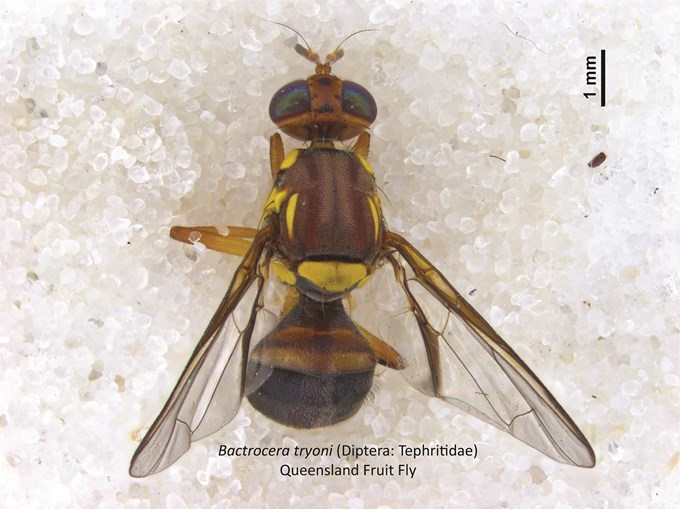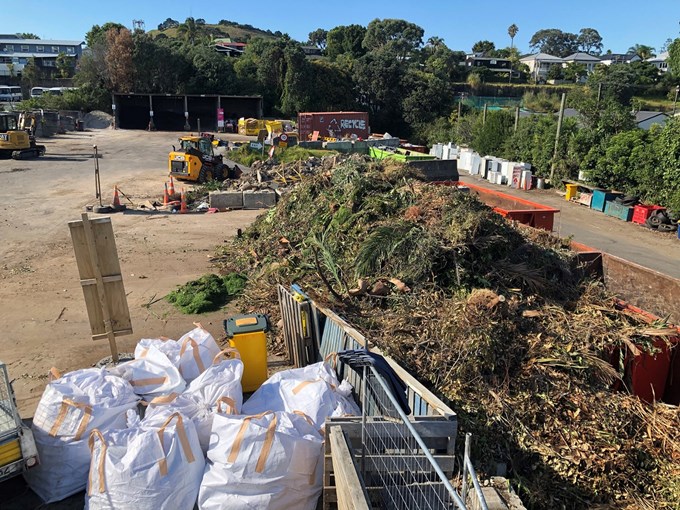As Biosecurity New Zealand restrictions enter their third week in Devonport, the Devonport Community Recycling Centre (DCRC) is working hard to continue to maximise diversion of green waste from landfill.
In the wake of the discovery of a Queensland Fruit Fly, a Controlled Area Notice (CAN) was issued by Biosecurity New Zealand on 15 February. This restricts the movement of certain fruit and vegetables out of the Controlled Area to help prevent the spread of any fruit flies.
As the DCRC is currently inside Zone B of the Devonport Controlled Area, this has led to restrictions being imposed on the centre by Biosecurity New Zealand as to how green waste is managed on- and off-site to comply with biosecurity regulations.
DCRC director, Andrew Walters, says they have been working very closely with Biosecurity New Zealand since the Notice was issued.
The restrictions mean that green waste now has to remain on-site at the DCRC, instead of being sent away to specialist composting processors.
Mulching to maximise landfill diversion
“Devonport Recycling Centre is doing all it can to optimise its ability to store and manage green waste on-site by shredding the green waste to reduce volume,” says Andrew Walters.
“We are now using a chipper, which helps to reduce the volume by around 30 to 40 per cent. Chipping can be a noisy operation. We have hired specialist sound reduction equipment but, even so, we ask our neighbours in the immediate vicinity to please bear with us during this time, as we try to achieve the best environmental outcomes within the unexpected constraints we face.”
Although mulching is helping to reduce the volume of material that is being delivered to DCRC, there is a limit to the storage space available. If on-site capacity is reached, green waste material delivered to DCRC will be contained in sealed bins and sent to landfill rather than being composted, in line with Biosecurity New Zealand’s guidelines.
“We may reach a point where we no longer have space to store and manage green waste on site. However, we want to do everything we can to support Biosecurity New Zealand to ensure that the fruit fly is eradicated from the Devonport area as soon as possible,” says Andrew Walters.
Bringing your green waste to DRC
A brochure with information and guidance about movement controls is available on Biosecurity New Zealand’s website. Here are some key points that customers need to know:
- Residents in Zones A and B should place any home-grown fruit or vegetable scraps in their nearest Biosecurity NZ bin
- Residents in Zone A cannot bring any specific risk green waste to DCRC
- For those residents in Zone A, specific risk garden waste should be put into specially supplied Biosecurity New Zealand bins
- Residents in Zone B can still bring their green waste to Devonport Recycling Centre, as long as they don’t go through Zone A on their way to drop off their green waste.
Understanding Specific Risk Green Waste
To help the recycling centre manage green waste coming from Zone B, residents are being asked to separate specific risk green waste out from other green waste and dispose of it in Biosecurity New Zealand bins at the recycling centre or other locations in Zone B.
The following items are considered specific risk green waste and should be separated out from other green waste:
- Lawn clippings where lawns have been mowed around fruit trees and there is a risk of fruit and tree material being part of the clippings
- Home-grown produce waste
- Planting material and associated soil attached to or in the vicinity of fruit trees
- Hedge trimmings from hedges made of fruit trees (e.g. feijoa hedges)
- Leaves and branches from fruit trees and vegetable waste from vegetable gardens (not including leafy greens).
“We are asking residents to do everything they can to make sure no home-grown fruit or vegetable scraps or specific risk green waste is included in any green waste delivered to the recycling centre, if at all possible,” says Andrew Walters.
“If you are taking green waste to the recycling centre that includes specific risk items, please ensure those items are separated out from the other green waste. Staff are on hand to help load specific risk green waste into specialist containment bags.”
Keep your garden waste inside the zone
Andrew Walters advises that Biosecurity New Zealand does not want specific risk green waste taken outside of the Controlled Zones. Therefore, it is critical that green waste is only brought to DCRC, which is within the Controlled Zone, or that residents follow Biosecurity New Zealand’s guidance to dispose of their green waste.
“We’d like to thank our customers and local residents for their support during this challenging time. We’ve been heartened to see how the community has pulled together and is doing the right thing with their fruit and vegetable scraps and green waste. We’re working extremely hard to play our part too,” says Walters.

Other fruit fly sightings
Three male fruit flies have also been found in traps in Northcote. Another species of fruit fly, the facialis fruit fly, was found in Otara.
Controlled Area Notices have also been issued in these areas.
For further information about restrictions on moving fruit and vegetables in the controlled areas, check out Biosecurity New Zealand’s website.


